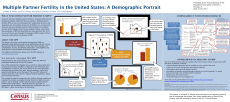Multiple Partner Fertility in the United States: A Demographic Portrait
Multiple Partner Fertility in the United States: A Demographic Portrait
Families in the United States have become more complex in recent decades, due in part to high rates of divorce and non-marital fertility. As families are disassembled and reassembled in new configurations, it seems a natural extension to assume that multiple partner fertility (MPF) will rise in prevalence, although existing data have generally been insufficient to describe the incidence of MPF in families. However, new data from the U.S. Census Bureau allow us to examine the prevalence of multiple partner fertility across individuals and families within the United States. Using data from Wave 1 of the 2014 Survey of Income and Program Participation (SIPP), I present a nationally-representative portrait of parents in the United States who have multiple partner fertility, providing a new foundation for the study of MPF going forward.
Data Note
This poster was first posted on April 27, 2017. It was re-released on August 31, 2017, after correcting an error in the two estimates shown in Figure 3.




